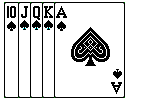MORE ABOUT KNOCKOUT TOURNIES
The introduction of the bounty presents some necessary strategy adjustments that I want to talk about in this article. In general, I observe players allowing the presence of the bounty affect their decisions too much. In other words, when a player moves all-in, they will call them with very marginal holdings in hopes of busting them out and receiving their bounty money. But remember, in almost all cases, the prize pool of the tournament is far larger than the bounties. This means you should essentially play the tournament like a normal tournament with a few small strategy adjustments.
It is important to realize how the bounty affects your decisions throughout the tournament. In the early stages of the tournament, knocking a player out and receiving a bounty carries more value than it does later in the tournament. This is because at the start of the tournament, you're really not worth that much. For example, if I buy into a $24+$2 bounty tournament, I might estimate that I am worth $35 in that tournament. In other words, right when I take my seat in that event, I expect to win an average of $9 off of my initial tournament buy-in. That's my "expected value".
In any tournament, your "value" in the event changes as the tournament drags on. So if I am "worth" $35 when I first take my seat, how would my value change if I doubled-up or busted out on the first hand? Well, if I busted out, I would obviously be worth $0 in the tournament. If I doubled-up, I might estimate that I'm worth more like $70.
As you get deeper and deeper in a tournament and accumulate more and more chips, your "worth" in the tournament continues to increase. Suppose you make the final table. Now your "worth" in the tournament is going to be way more than the $35 it was at the beginning of the tournament. It might now be worth a few thousand depending on how large the prize pool is.
Once you have established how many chips a bounty is worth, you can use this number to make decisions at the poker table. Suppose the blinds are 50/100. You have 2,000 chips in the big blind. It folds to the small blind who moves all-in for 1,500 chips. When weighing whether or not to call, don't view the pot as having 1,600 chips, view the pot as having 2,100 chips (add 500 chips for the value of the bounty) and make your decision based on those pot odds. It's really as simple as that.
As you can see, making calls for the purpose of receiving a bounty becomes a moot point later in the tournament. When you're weighing whether or not to make a call in a pot of 43,000 chips, the extra 500 added for the bounty value matters only marginally. By the time you reach the final table, the bounties should not even be a thought on your mind.
Everyone posting their opinion on this info will be in a random draw for $30. |


 193800
193800 2000
2000 0
0 1500.00
1500.00
 694292
694292 2000
2000 0
0 1500.00
1500.00